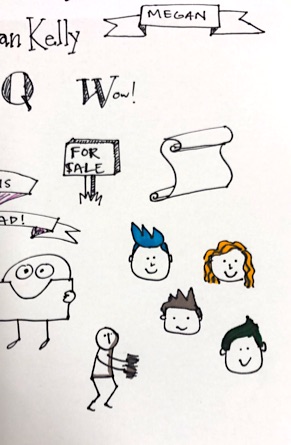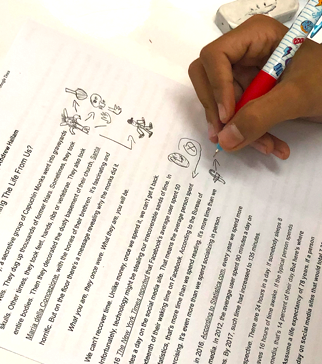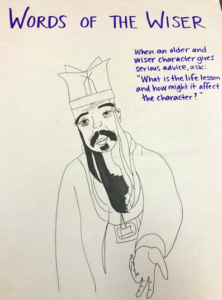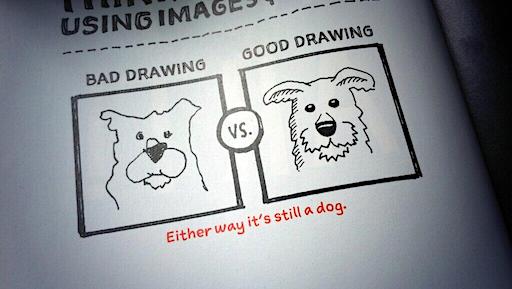Using Sketchnotes and Doodles in ELA Lessons
A MiddleWeb Blog
 One of the unexpected benefits of having a toddler is the influx of hands-on art in my life. I haven’t painted, colored, or illustrated this much since I was in elementary school. This renaissance reminded me of how important creativity is in our students’ educational lives.
One of the unexpected benefits of having a toddler is the influx of hands-on art in my life. I haven’t painted, colored, or illustrated this much since I was in elementary school. This renaissance reminded me of how important creativity is in our students’ educational lives.
I was even more determined to act on this insight after a recent study found that drawing can improve our memory more than re-writing or visualizing because it activates more areas of the brain.
With this in mind, I set out to incorporate art into my English class – without it becoming “Language Arts and Crafts.”
Once I decided to add more art to my lessons, opportunities quickly presented themselves. My school hosted a workshop with famed sketchnote guru, Sylvia Duckworth. I learned that artistic talent is not required and that anyone can draw small doodles to take notes.
After a day full of learning, we practiced on a TED Talk and it was an eye-opening experience. Since I couldn’t draw everything, I truly had to consider what were the most important points and jot them down quickly. When I went back to fill in my drawings, I thought about the TED speech again, which had me processing the information a second time. It was a pain-free method of reviewing information.
I tried sketchnoting with my students in small steps. First, I gave them an article with an extra wide right margin. I drew lines at various points in the article; once students reached the line, they had to draw the main idea from that section. The back of the article was a blank page with the direction to draw the overall message of the article.
When students reflected on the activity, they reported that they enjoyed it and that they tend to remember the things they draw. The only complaint came from a student who said it took way longer than just underlining, so “I had to think more.” Sounds like a win to me.
I took another idea from Chip and Dan Heath’s The Power of Moments, where I learned that children’s hospitals in Scotland use a drawing asking patients, “What matters to you?” I made this the first assignment in our memoir unit, inside their writer’s notebooks. This would serve as a reminder for story ideas and a way for me to get to know the students even better. When I asked the students how they felt about the activity, they said they found it relaxing.
Moving into a new unit, there are many informational charts to be made. Fortunately, I am the advisor for the Graphic Novel Club at school and many of my students are excellent artists. They created posters based on Kylene Beers and Robert Probst’s Notice and Note strategies, illustrating the signposts in ways they knew would connect with their classmates. (Your students don’t have to be artistic to make posters, and they will instantly ‘own’ the information they create.)
Developing an icon bank
ELA teachers often ask students to make connections and comparisons between texts. One way to help students with this skill is to work together to create an icon bank with different images symbolizing different themes or ideas.
Once your class has a shared visual representation for concepts like friendship, freedom, etc., they can then use them to represent their reading. At the end of each book, ask students to choose the three icons that best represent the theme of their book. This will make it easy for them to see which texts share common themes.
On his blog, Larry Ferlazzo offers a worksheet that he uses with ELL students to learn new vocabulary. I suggest doing a similar activity with all students, especially when you know there is complex vocabulary in the text you will read. Students can compare their drawings with a partner and explain the choices they made, which should reinforce their ideas and clear up any confusion.
My next goal is to add more art to my students’ book clubs. One idea I had was to draw a character’s name so that it looks like their traits. For example, to draw Katniss from The Hunger Games, I made the T a bow and arrow for her skills, then a compass for her ability to follow her heart, and the S as a question mark because she is unpredictable.
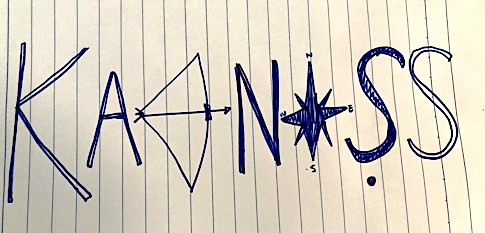
My sample drawing of a character name.
This exercise had me thinking critically about the character’s traits, how to represent them, and how they would fit with the letters available. I also think it’s nice for students to see my work is something they can surpass! I know this is just the beginning of adding art into book clubs. I would love to hear any ideas you have in the comments.
Some further reading:
“Sketchnotes can feature simple artwork or fancy artwork, but it’s the structure of the notes that matters most. That’s why simple lines, circles, arrows, and stick figures can be just as useful as more highly rendered elements of sketchnotes.” (Derek Bruff, Director of the Vanderbilt Center for Teaching, Source)

